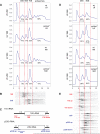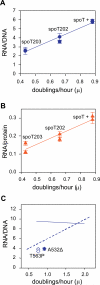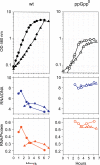ppGpp is the major source of growth rate control in E. coli
- PMID: 20946586
- PMCID: PMC4556285
- DOI: 10.1111/j.1462-2920.2010.02357.x
ppGpp is the major source of growth rate control in E. coli
Abstract
It is widely accepted that the DNA, RNA and protein content of Enterobacteriaceae is regulated as a function of exponential growth rates; macromolecular content increases with faster growth regardless of specific composition of the growth medium. This phenomenon, called growth rate control, primarily involves regulation of ribosomal RNA and ribosomal protein synthesis. However, it was uncertain whether the global regulator ppGpp is the major determinant for growth rate control. Therefore, here we re-evaluate the effect of ppGpp on macromolecular content for different balanced growth rates in defined media. We find that when ppGpp is absent, RNA/protein and RNA/DNA ratios are equivalent in fast and slow growing cells. Moreover, slow growing ppGpp-deficient cells with increased RNA content, display a normal ribosomal subunit composition although polysome content is reduced when compared with fast growing wild-type cells. From this we conclude that growth rate control does not occur in the absence of ppGpp. Also, artificial elevation of ppGpp or introduction of stringent RNA polymerase mutants in ppGpp-deficient cells restores this control. We believe these findings strongly argue in favour of ppGpp and against redundant regulation of growth rate control by other factors in Escherichia coli and other enteric bacteria.
Published 2010. This article is a US Government work and is in the public domain in the USA.
Figures





Similar articles
-
Characterization of RNA and DNA synthesis in Escherichia coli strains devoid of ppGpp.J Biol Chem. 1993 May 25;268(15):10851-62. J Biol Chem. 1993. PMID: 7684368
-
Physiological characterization of Escherichia coli rpoB mutants with abnormal control of ribosome synthesis.J Bacteriol. 1983 Sep;155(3):1162-70. doi: 10.1128/jb.155.3.1162-1170.1983. J Bacteriol. 1983. PMID: 6193095 Free PMC article.
-
Toxic effects of high levels of ppGpp in Escherichia coli are relieved by rpoB mutations.J Biol Chem. 1992 Feb 5;267(4):2337-44. J Biol Chem. 1992. PMID: 1370817
-
Regulation of ribosomal RNA synthesis in E. coli: effects of the global regulator guanosine tetraphosphate (ppGpp).J Mol Microbiol Biotechnol. 2002 May;4(3):331-40. J Mol Microbiol Biotechnol. 2002. PMID: 11931566 Review.
-
ppGpp: a global regulator in Escherichia coli.Trends Microbiol. 2005 May;13(5):236-42. doi: 10.1016/j.tim.2005.03.008. Trends Microbiol. 2005. PMID: 15866041 Review.
Cited by
-
Lowering GTP level increases survival of amino acid starvation but slows growth rate for Bacillus subtilis cells lacking (p)ppGpp.J Bacteriol. 2014 Jun;196(11):2067-76. doi: 10.1128/JB.01471-14. Epub 2014 Mar 28. J Bacteriol. 2014. PMID: 24682323 Free PMC article.
-
The E. coli Global Regulator DksA Reduces Transcription during T4 Infection.Viruses. 2018 Jun 6;10(6):308. doi: 10.3390/v10060308. Viruses. 2018. PMID: 29882792 Free PMC article.
-
High coverage metabolomics analysis reveals phage-specific alterations to Pseudomonas aeruginosa physiology during infection.ISME J. 2016 Aug;10(8):1823-35. doi: 10.1038/ismej.2016.3. Epub 2016 Feb 16. ISME J. 2016. PMID: 26882266 Free PMC article.
-
Within and beyond the stringent response-RSH and (p)ppGpp in plants.Planta. 2017 Nov;246(5):817-842. doi: 10.1007/s00425-017-2780-y. Epub 2017 Sep 25. Planta. 2017. PMID: 28948393 Free PMC article. Review.
-
Modeling the Overproduction of Ribosomes when Antibacterial Drugs Act on Cells.Biophys J. 2016 Feb 2;110(3):743-748. doi: 10.1016/j.bpj.2015.12.016. Biophys J. 2016. PMID: 26840738 Free PMC article.
References
-
- Aberg A, Shingler V, Balsalobre C. Regulation of the fimB promoter: a case of differential regulation by ppGpp and DksA in vivo. Mol Microbiol. 2008;67:1223–1241. - PubMed
-
- Baracchini E, Bremer H. Control of rRNA synthesis in Escherichia coli at increased rrn gene dosage. Role of guanosine tetraphosphate and ribosome feedback. J Biol Chem. 1991;266:11753–11760. - PubMed
-
- Bugl H, Fauman EB, Staker BL, Zheng F, Kushner SR, Saper MA, Bardwell JCA, Jakob U. RNA methylation under heat shock control. Mol Cell. 2000;6:349–360. - PubMed
-
- Bremer H, Dennis PP. Modulation of chemical composition and other parameters of the cell by growth rate. In: Neidhardt FC, editor. Escherichia coli and Salmonella: cellular and molecular biology. ASM Press; Washington DC: 1996. pp. 1553–1569.
Publication types
MeSH terms
Substances
Grants and funding
LinkOut - more resources
Full Text Sources
Other Literature Sources

